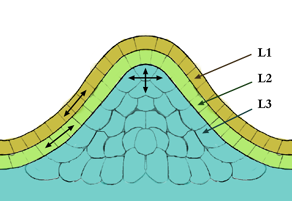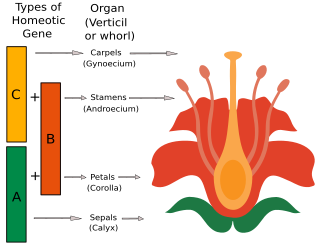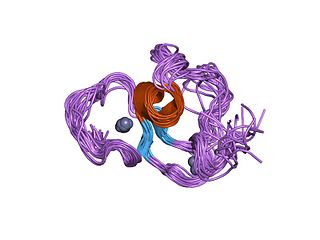Related Research Articles

In molecular biology, a transcription factor (TF) is a protein that controls the rate of transcription of genetic information from DNA to messenger RNA, by binding to a specific DNA sequence. The function of TFs is to regulate—turn on and off—genes in order to make sure that they are expressed in the desired cells at the right time and in the right amount throughout the life of the cell and the organism. Groups of TFs function in a coordinated fashion to direct cell division, cell growth, and cell death throughout life; cell migration and organization during embryonic development; and intermittently in response to signals from outside the cell, such as a hormone. There are 1500-1600 TFs in the human genome. Transcription factors are members of the proteome as well as regulome.

An inflorescence, in a flowering plant, is a group or cluster of flowers arranged on a stem that is composed of a main branch or a system of branches. An inflorescence is categorized on the basis of the arrangement of flowers on a main axis (peduncle) and by the timing of its flowering.

Vernalization is the induction of a plant's flowering process by exposure to the prolonged cold of winter, or by an artificial equivalent. After vernalization, plants have acquired the ability to flower, but they may require additional seasonal cues or weeks of growth before they will actually do so. The term is sometimes used to refer to the need of herbal (non-woody) plants for a period of cold dormancy in order to produce new shoots and leaves, but this usage is discouraged.

The meristem is a type of tissue found in plants. It consists of undifferentiated cells capable of cell division. Cells in the meristem can develop into all the other tissues and organs that occur in plants. These cells continue to divide until a time when they get differentiated and then lose the ability to divide.

DNA-binding proteins are proteins that have DNA-binding domains and thus have a specific or general affinity for single- or double-stranded DNA. Sequence-specific DNA-binding proteins generally interact with the major groove of B-DNA, because it exposes more functional groups that identify a base pair.

Helix-turn-helix is a DNA-binding protein (DBP). The helix-turn-helix (HTH) is a major structural motif capable of binding DNA. Each monomer incorporates two α helices, joined by a short strand of amino acids, that bind to the major groove of DNA. The HTH motif occurs in many proteins that regulate gene expression. It should not be confused with the helix–loop–helix motif.

In molecular genetics, a repressor is a DNA- or RNA-binding protein that inhibits the expression of one or more genes by binding to the operator or associated silencers. A DNA-binding repressor blocks the attachment of RNA polymerase to the promoter, thus preventing transcription of the genes into messenger RNA. An RNA-binding repressor binds to the mRNA and prevents translation of the mRNA into protein. This blocking or reducing of expression is called repression.

A leucine zipper is a common three-dimensional structural motif in proteins. They were first described by Landschulz and collaborators in 1988 when they found that an enhancer binding protein had a very characteristic 30-amino acid segment and the display of these amino acid sequences on an idealized alpha helix revealed a periodic repetition of leucine residues at every seventh position over a distance covering eight helical turns. The polypeptide segments containing these periodic arrays of leucine residues were proposed to exist in an alpha-helical conformation and the leucine side chains from one alpha helix interdigitate with those from the alpha helix of a second polypeptide, facilitating dimerization.
Florigens are proteins capable of inducing flowering time in Angiosperms. The prototypical florigen is encoded by the FT gene and its orthologs in Arabidopsis and other plants. Florigens are produced in the leaves, and act in the shoot apical meristem of buds and growing tips.

The ABC model of flower development is a scientific model of the process by which flowering plants produce a pattern of gene expression in meristems that leads to the appearance of an organ oriented towards sexual reproduction, a flower. There are three physiological developments that must occur in order for this to take place: firstly, the plant must pass from sexual immaturity into a sexually mature state ; secondly, the transformation of the apical meristem's function from a vegetative meristem into a floral meristem or inflorescence; and finally the growth of the flower's individual organs. The latter phase has been modelled using the ABC model, which aims to describe the biological basis of the process from the perspective of molecular and developmental genetics.
The MADS box is a conserved sequence motif. The genes which contain this motif are called the MADS-box gene family. The MADS box encodes the DNA-binding MADS domain. The MADS domain binds to DNA sequences of high similarity to the motif CC[A/T]6GG termed the CArG-box. MADS-domain proteins are generally transcription factors. The length of the MADS-box reported by various researchers varies somewhat, but typical lengths are in the range of 168 to 180 base pairs, i.e. the encoded MADS domain has a length of 56 to 60 amino acids. There is evidence that the MADS domain evolved from a sequence stretch of a type II topoisomerase in a common ancestor of all extant eukaryotes.
Superman is a plant gene in Arabidopsis thaliana, that plays a role in controlling the boundary between stamen and carpel development in a flower. It is named for the comic book character Superman, and the related genes kryptonite (gene) and clark kent were named accordingly. It encodes a transcription factor. Homologous genes are known in the petunia and snapdragon, which are also involved in flower development, although in both cases there are important differences from the functioning in Arabidopsis. Superman is expressed early on in flower development, in the stamen whorl adjacent to the carpel whorl. It interacts with the other genes of the ABC model of flower development in a variety of ways.

The PHD finger was discovered in 1993 as a Cys4-His-Cys3 motif in the plant homeodomain proteins HAT3.1 in Arabidopsis and maize ZmHox1a. The PHD zinc finger motif resembles the metal binding RING domain (Cys3-His-Cys4) and FYVE domain. It occurs as a single finger, but often in clusters of two or three, and it also occurs together with other domains, such as the chromodomain and the bromodomain.

Apetala 2(AP2) is a gene and a member of a large family of transcription factors, the AP2/EREBP family. In Arabidopsis thaliana AP2 plays a role in the ABC model of flower development. It was originally thought that this family of proteins was plant-specific; however, recent studies have shown that apicomplexans, including the causative agent of malaria, Plasmodium falciparum encode a related set of transcription factors, called the ApiAP2 family.
Evolutionary developmental biology (evo-devo) is the study of developmental programs and patterns from an evolutionary perspective. It seeks to understand the various influences shaping the form and nature of life on the planet. Evo-devo arose as a separate branch of science rather recently. An early sign of this occurred in 1999.
Important structures in plant development are buds, shoots, roots, leaves, and flowers; plants produce these tissues and structures throughout their life from meristems located at the tips of organs, or between mature tissues. Thus, a living plant always has embryonic tissues. By contrast, an animal embryo will very early produce all of the body parts that it will ever have in its life. When the animal is born, it has all its body parts and from that point will only grow larger and more mature. However, both plants and animals pass through a phylotypic stage that evolved independently and that causes a developmental constraint limiting morphological diversification.

Upstream stimulatory factor 1 is a protein that in humans is encoded by the USF1 gene.
In molecular biology, the protein domain TCP is actually a family of transcription factors named after: teosinte branched 1, cycloidea (cyc) and PCF in rice.
EARLY FLOWERING 3 (ELF3) is a plant-specific gene that encodes the hydroxyproline-rich glycoprotein and is required for the function of the circadian clock. ELF3 is one of the three components that make up the Evening Complex (EC) within the plant circadian clock, in which all three components reach peak gene expression and protein levels at dusk. ELF3 serves as a scaffold to bind EARLY FLOWERING 4 (ELF4) and LUX ARRHYTHMO (LUX), two other components of the EC, and functions to control photoperiod sensitivity in plants. ELF3 also plays an important role in temperature and light input within plants for circadian clock entrainment. Additionally, it plays roles in light and temperature signaling that are independent from its role in the EC.
Doris Wagner is an American biologist who is the Robert I. Williams Term Professor of Biology at the University of Pennsylvania. Her research looks to better understand the structure-function relationships of plant cells. She established the Epigenomics of Plants International Consortium. Wagner is a Fellow of the American Society of Plant Biologists.
References
- ↑ Weigel D, Alvarez J, Smyth DR, Yanofsky MF, Meyerowitz EM (1992). "LEAFY controls floral meristem identity in Arabidopsis" (PDF). Cell. 69 (5): 843–859. doi: 10.1016/0092-8674(92)90295-N . PMID 1350515.
- ↑ Sayou, Camille; Monniaux, Marie; Nanao, Max H.; Moyroud, Edwige; Brockington, Samuel F.; Thévenon, Emmanuel; Chahtane, Hicham; Warthmann, Norman; Melkonian, Michael (2014-02-07). "A promiscuous intermediate underlies the evolution of LEAFY DNA binding specificity". Science. 343 (6171): 645–648. Bibcode:2014Sci...343..645S. doi:10.1126/science.1248229. hdl: 1885/64773 . ISSN 1095-9203. PMID 24436181. S2CID 207778924.
- ↑ Peter M. Hollingsworth; Richard M. Bateman; R. J. Gornall (1999). Molecular Systematics and Plant Evolution. CRC Press. p. 242. ISBN 978-0-7484-0908-2.
- ↑ Weigel D, Nilsson O (1995). "A developmental switch sufficient for flower initiation in diverse plants". Nature. 377 (6549): 495–500. Bibcode:1995Natur.377..495W. doi:10.1038/377495a0. PMID 7566146. S2CID 4346606.
- ↑ Hamès, Cécile; Ptchelkine, Denis; Grimm, Clemens; Thevenon, Emmanuel; Moyroud, Edwige; Gérard, Francine; Martiel, Jean-Louis; Benlloch, Reyes; Parcy, François (2008-10-08). "Structural basis for LEAFY floral switch function and similarity with helix-turn-helix proteins". The EMBO Journal. 27 (19): 2628–2637. doi:10.1038/emboj.2008.184. ISSN 1460-2075. PMC 2567413 . PMID 18784751.
- ↑ Sayou, Camille; Nanao, Max H.; Jamin, Marc; Posé, David; Thévenon, Emmanuel; Grégoire, Laura; Tichtinsky, Gabrielle; Denay, Grégoire; Ott, Felix (2016-04-21). "A SAM oligomerization domain shapes the genomic binding landscape of the LEAFY transcription factor". Nature Communications. 7: 11222. Bibcode:2016NatCo...711222S. doi:10.1038/ncomms11222. ISSN 2041-1723. PMC 4844672 . PMID 27097556.
- ↑ Moyroud, Edwige; Minguet, Eugenio Gómez; Ott, Felix; Yant, Levi; Posé, David; Monniaux, Marie; Blanchet, Sandrine; Bastien, Olivier; Thévenon, Emmanuel (2011-04-01). "Prediction of regulatory interactions from genome sequences using a biophysical model for the Arabidopsis LEAFY transcription factor". The Plant Cell. 23 (4): 1293–1306. doi:10.1105/tpc.111.083329. ISSN 1532-298X. PMC 3101549 . PMID 21515819.
- ↑ Winter, Cara M.; Austin, Ryan S.; Blanvillain-Baufumé, Servane; Reback, Maxwell A.; Monniaux, Marie; Wu, Miin-Feng; Sang, Yi; Yamaguchi, Ayako; Yamaguchi, Nobutoshi (2011-04-19). "LEAFY target genes reveal floral regulatory logic, cis motifs, and a link to biotic stimulus response". Developmental Cell. 20 (4): 430–443. doi: 10.1016/j.devcel.2011.03.019 . ISSN 1878-1551. PMID 21497757.
- ↑ Rieu, Philippe; Turchi, Laura; Thévenon, Emmanuel; Zarkadas, Eleftherios; Nanao, Max; Chahtane, Hicham; Tichtinsky, Gabrielle; Lucas, Jérémy; Blanc-Mathieu, Romain; Zubieta, Chloe; Schoehn, Guy; Parcy, François (2023-02-02). "The F-box protein UFO controls flower development by redirecting the master transcription factor LEAFY to new cis-elements" (PDF). Nature Plants. 9 (2): 315–329. doi:10.1038/s41477-022-01336-2. ISSN 2055-0278. PMID 36732360. S2CID 256545937.